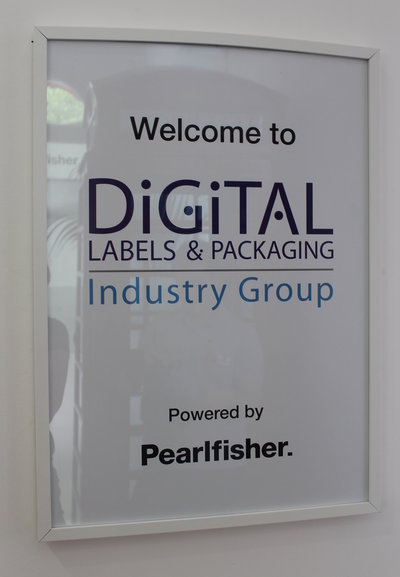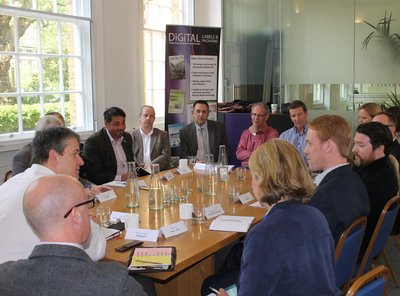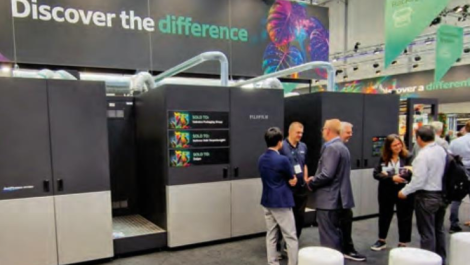As brands are gradually taking onboard the advantages of digital printing and we are seeing more and more successful campaigns enabled by the technology, Digital Labels & Packaging invited its industry group members to a debate on the future of digital print and the impact on brands. Neel Madsen reports.
The first meeting of the Digital Labels & Packaging industry group in 2014 took the form of a roundtable discussion hosted by Pearlfisher at their offices in Hammersmith on 24 April. The brands, printers and designers present enjoyed a lively debate and shared their experiences of implementing campaigns and producing packaging at the cutting edge of the industry.
The opportunities afforded by digital print continue to evolve, and brands are using the technology more and more to get shorter runs on the shelf, try out new designs and engage in a two way conversation with their consumers. The debate looked at these, and many other drivers, and at the new ideas that are emerging as well as revisiting successful recent campaigns.
In his welcome to the group, realisation director of Pearlfisher, Shaun Jones, said, ‘Six months ago, I was pretty naïve in my understanding of digital print. It is a very exciting and interesting technology, and I think we will see a real explosion in the use of digital. It is about using it in the right way and there are a lot of fantastic opportunities open to us and to brands to make a real difference.’
The debate was moderated by technical editor Sean Smyth, and participants included Trevor Smith, Amberley Labels, Grant Picking, Berkshire Labels, Andrew Degnan, Chesapeake, Simon Smith, CS Labels, Stuart Kellock, Label Apeel, Darren Dutton, Links Labels & Tapes, Syd Reading, Readyprint, Steve Buxton, YRG Solutions, Kevin Laughton, Sharp Iris, John Nicholson, TwiningsOvo, Patrice Finnegan, Associated British Foods plc, Shaun Jones, Pearlfisher, Gregory Bentley, The Coca-Cola Company, Paul Day, Neal’s Yard Remedies, and Marie Rushton, Digital Labels & Packaging.

Watershed moment
‘What do you need to do to really sell digital, and how do you engage with customers and brands?’, asked Sean Smyth, as an opening gambit. He took the opportunity to direct this at Gregory Bentley, packaging innovator at the Coca-Cola Company, who ran the ‘Share A coke with …’ campaign, which Mr Smyth described as ‘a watershed moment in the adoption of digital printing’.
Mr Bentley was happy to share his experiences and told the story of how the campaign was run in various European countries. He said, ‘To dream of putting people’s names on Coke bottles, like we did, was unthinkable just five years ago. We were looking around for a way to implement the campaign and digital enabled us to realise it, it was simple – use digital or don’t do it at all.’
The project showcased versioning at its most advanced level and how the brand can communicate directly with the customer. As Mr Bentley explained, ‘Any product that goes on the supermarket shelf with variable packaging designs is ‘versioning’ not personalisation, but this project became personalisation when customers chose the bottle with their name on it.’
Packaging has struggled in the past to react quickly to market trends, but with digital there is now a real opportunity for it to play a bigger part in the marketing of the product and open up the dialogue with customers. Shaun Jones said, ‘I’m interested in how we can tell the story of the brand via the packaging.’ He also pointed out the interesting dichotomy between digital enabling mammoth campaigns while at the same time being perfect for micro brands that are trying to get on shelf and can only do so by having the packaging printed digitally.
Education needed
The conversation turned to issues that are still creating obstacles, such as the supply chain, the general perception of digital as a technology just for very short runs and the need to communicate the benefits to brands and designers.
Simon Smith said, ‘We are purely digital and can’t sell on price, but the benefits include not having to spend as much on advertising because the label can now interact with the market place. There are so many exciting things you can do with digital that conventional technologies can’t do, but you need to design the label with the technology in mind and involve the printer early in the process. Our problem is often that by the time we see the design, it is too late for us to have a say.’
Trevor Smith agreed. ‘We need to communicate our capabilities and address the supply chain issue. The printing is the easy part. There needs to be more awareness out there.’ Grant Picking said, ‘It is key that we talk to the right people and get the message across to the marketer not just the print buyer who is always concerned with costs. They need to start thinking digital.’
Stuart Kellock commented, ‘Getting into digital has allowed me to move more into the brand and marketing side, and speak to designers and brands. The barrier is really education of the customers not the costs, and the beauty of this kit is that it allows us to be much more than just a printer.’
Brand view
For some brands, digital has already played a critical role in their growth. Neal’s Yard Remedies has worked closely with Amberley Labels getting its labels and packaging produced digitally across its 4000+ product lines. Paul Day is the brand’s packaging technologist and he said, ‘Digital has been an opportunity for us to grow as a brand and enabled us to get into foreign markets. It was the only way it could make financial sense to expand across the globe and it gives us complete flexibility.’
Others are still considering digital. John Nicholson, packaging development manager, TwiningsOvo, said that digital offers lower costs in terms of repro and it is a dream for the marketers who can get some projects off the ground that would not have been possible before. He also acknowledged the importance of communication.
He said, ‘If we are creating a new design, it is important that there is consultation across the board between all parties involved. We now have technical meetings, which get everyone around the table and iron out potential problems early on in the process. It never used to happen, but this way really works for us.’
Takeaway
The feedback from the participants was overwhelmingly positive and there was a general agreement that the format worked. Speaking after the debate, Shaun Jones said, ‘Education is paramount and certainly in the last six months, I have been looking at digital and learnt a lot through conferences and event. These have really highlighted to me how we can optimise our thinking by using this technology. Events, like this one today, are vital to pulling together the key stakeholders who can really make things happen and help us move forward. It is absolutely critical that we have brand owners and printers around the table at the same time.’
Kevin Laughton, director at Sharp Iris, commented, ‘The digital world is very different to the way the older conventional one works. It has been very interesting to come here and experience printers talking openly to each other, debating techniques and ways of engaging with brands.’
Trevor Smith said, ‘We have come away today with some learning from our peers and competitors as well more understanding of how brand thinking works, what is important for them and how we can translate that for our own brand customers.’
John Nicholson agreed, ‘I’ve got quite a passion for open innovation and the way these events are run is just perfect for meeting people in the industry and exchange ideas.’
‘We’ve had a fantastic discussion today and I am really pleased with how the event has gone,’ concluded Marie Rushton. ‘There were some very interesting points made about engaging the customer and how we can move forward using new technologies. It was a really good mix of talking about experiences we’ve already had as an industry and then moving on to what is likely to happen in the future.’
The next event will be a one-day conference in London on 6 November under the theme ‘Digital Print for Brand Success’. For more information, please contact chloe.w@whitmar.co.uk.






